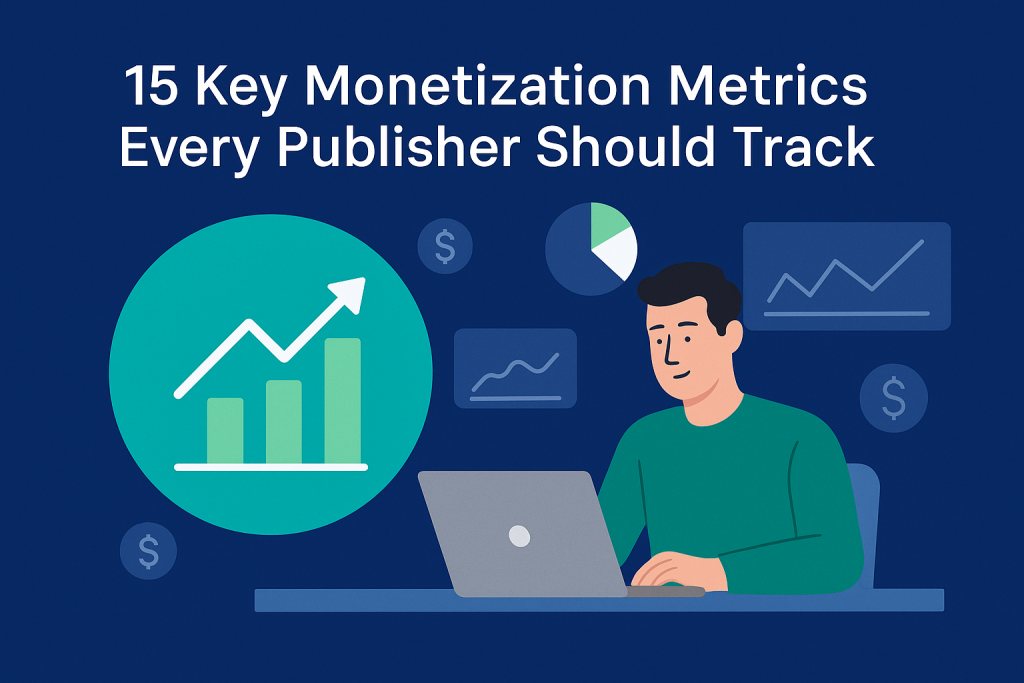Ad monetization is the process of generating revenue from digital assets—such as websites, mobile apps, or blogs—by displaying advertisements. For publishers, it has evolved into a core business model that supports content creation and platform growth.
Whether through direct sales, programmatic channels, or hybrid models, monetization enables publishers to earn revenue based on ad impressions, clicks, or user engagement.

The Role of Data in Monetization
In today’s fast-paced programmatic ecosystem, data is the true currency. Yet, with dozens of metrics available across SSP dashboards, Google Ad Manager, and analytics tools, it’s easy to lose sight of what actually impacts the bottom line.
At iPROM Yield, we help premium publishers across Central and Eastern Europe cut through the noise—focusing on performance indicators that directly influence revenue growth.
15 Key Monetization KPIs Every Publisher Should Track
To build a scalable and sustainable monetization strategy, understanding the right metrics is crucial. We’ve identified the 15 most impactful KPIs that will help you measure success, uncover inefficiencies, and fine-tune your programmatic strategy.
eCPM (Effective Cost Per Mille)
eCPM = (Total Revenue / Total Impressions) x 1000
This metric standardizes revenue across all channels, partners, and formats. It helps publishers understand the true value of their inventory regardless of pricing model (CPC, CPA, CPM).
Why it matters: It allows you to compare performance across pages, demand sources, and time periods. An essential metric for optimizing floor prices and partner prioritization.
2. Viewability Rate
The percentage of impressions that are considered “viewable” by MRC standards (e.g., 50% in-view for at least 1 second).
Why it matters: Advertisers pay more for viewable impressions. Low viewability reduces demand and CPMs.
Pro tip: Use lazy loading, sticky ads, and better ad placement to improve this.
3. Ad Fill Rate
Fill Rate = (Filled Impressions / Total Ad Requests) x 100
Why it matters: A low fill rate can signal problems with demand, targeting, or policy issues. Ensuring a high fill rate helps maximize available inventory.
Optimization tip: Use multiple SSPs via header bidding to increase fill.
4. Revenue Per Session (RPS)
RPS = Total Revenue / Total Sessions
This metric reflects the overall efficiency of monetization per user session, including across multiple pageviews and ad impressions.
Why it matters: It helps balance monetization with user experience. High RPS with low bounce rate = strong monetization strategy.
5. Page RPM (Revenue Per Mille)
Page RPM = (Total Revenue / Page Views) x 1000
Why it matters: Indicates how well each page is monetized. Helps identify high- or low-performing content.
Use case: Combine with analytics to prioritize top-earning content sections.
6. Bid Rate
The percentage of bid requests that actually receive bids.
Why it matters: Shows how attractive your inventory is to demand partners. Low bid rate = underperforming ad units or lack of demand.
Fix: Adjust floor prices, check creatives policies, or diversify demand.
7. Timeout Rate
The percentage of header bidding partners that didn’t respond before the auction timeout.
Why it matters: Lost bids = lost revenue. A high timeout rate may mean your timeout setting is too short.
Tip: Adjust Prebid timeout to 1000-1500ms for optimal balance.
8. Latency
Refers to how long ads take to load on your site.
Why it matters: High latency hurts UX and viewability. Users may leave before ads load.
Solution: Optimize ad scripts, reduce waterfall calls, use async loading.
9. CTR (Click-Through Rate)
CTR = (Clicks / Impressions) x 100
Why it matters: While not always key in programmatic, CTR is critical for native ads, direct campaigns, and engagement insights.
Low CTR fix: Improve creatives, placements, or use more engaging formats.
10. Ad Density
Measures how many ads appear per page relative to content.
Why it matters: Too high = bad UX, SEO penalties. Too low = lost revenue.
Optimal range: 15-30% ad-to-content ratio. Test and balance.
11. Invalid Traffic (IVT) Rate
Tracks non-human or fraudulent traffic, flagged by verification tools.
Why it matters: High IVT leads to revenue clawbacks and partner bans.
Prevention: Use reputable traffic sources and anti-IVT vendors (e.g., IAS, Moat).
12. Auction Overlap
Measures how many bidders are active per impression in header bidding.
Why it matters: More overlap = more competition = higher CPMs.
Fix: Add or rotate underperforming SSPs to increase auction pressure.
13. Viewable Impression RPM
Revenue per 1,000 viewable impressions.
Why it matters: More precise than standard RPM. Reflects true advertiser value and helps fine-tune pricing strategy.
Use case: Use this metric to evaluate ad placements and formats.
14. Ad Refresh Revenue
Revenue generated from refreshing ads within a single session (e.g., viewability-based refresh).
Why it matters: Boosts RPS without harming UX if implemented smartly.
Warning: Overuse can trigger penalties or lower viewability.
15. Top GEO Revenue Breakdown
Breaks down revenue and CPM by user geography.
Why it matters: Helps optimize geo-based pricing, content, and demand allocation.
Pro tip: Use country-specific floor prices and demand partners where possible.
Final Thoughts
Tracking the right monetization metrics isn’t just about numbers—it’s about making informed decisions that unlock higher revenue, better user experience, and smarter demand strategy. By focusing on the KPIs that actually impact your bottom line, you create a more agile and effective monetization framework.
At iPROM, we not only help publishers with improvements based on these insights, but also offer strategic consulting, AdServer integration, Prebid integration, demand stack optimization, and proactive partner management across the Central and Southeast Europe region.
Want to understand how your site stacks up? Need help pinpointing bottlenecks or underperforming ad units?
Contact our team and request a free monetization health check. We’ll help you benchmark against industry peers and unlock new growth opportunities.

